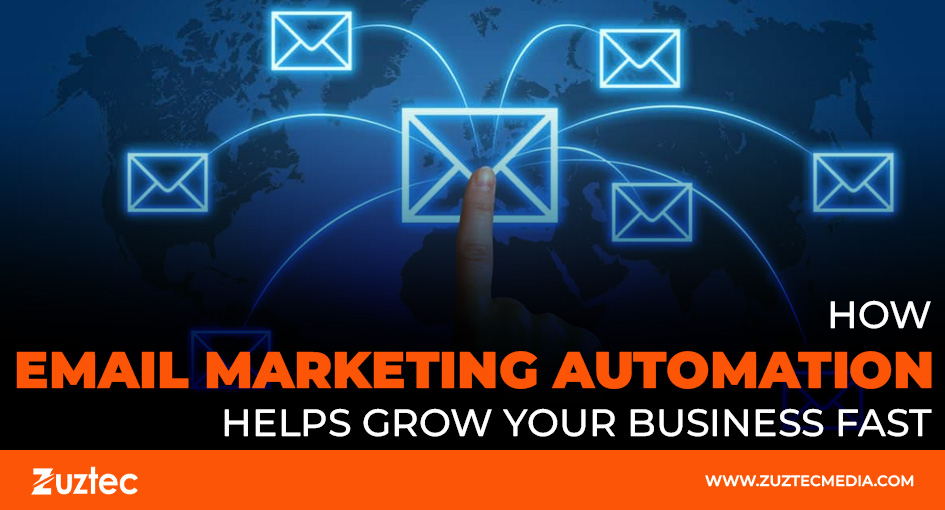
How Email Marketing Automation Helps Grow Your Business Fast
Businesses have long found that email marketing is an effective way to engage with their audience. But in today’s fast-paced digital world, simply sending out newsletters or promotional emails isn’t enough. It transforms traditional email marketing into a smarter, more efficient, and highly personalized process that works while you sleep.
Email marketing automation uses software to automatically send emails based on predefined triggers and behaviors. Actions like a user making a purchase, leaving a shopping cart empty, or subscribing to a newsletter are examples of these triggers. Automation enables companies to deliver the appropriate message to the appropriate individual at the appropriate time rather than sending one-size-fits-all communications.
The biggest advantage of automation in email marketing is its ability to scale personalized communication without extra effort. With a well-planned strategy, companies can nurture leads, onboard new customers, follow up after purchases, and even re-engage inactive subscribers. All of this happens without manual input once the automation is set up, saving time and increasing engagement.
In addition to conversions, marketers can monitor open rates and click-through rates. This data allows for continuous optimization and better targeting. As a result, campaigns become more effective, increasing the return on investment (ROI) for email marketing efforts.
In this article, we’ll dive deep into the world of automation in email marketing. You’ll discover how it functions, why it’s important, and which tools and tactics may support the expansion of your company. Whether you’re just starting or looking to refine your approach, this guide offers everything you need to understand and implement automation in email marketing successfully.
What Is Email Marketing Automation?
Sending emails to your subscribers in response to predetermined triggers and rules is known as automation. These emails are sent automatically, allowing marketers to deliver personalized messages without manually writing and scheduling each one.
It includes welcome emails, birthday greetings, purchase confirmations, cart abandonment follow-ups, and more. Instead of reacting to events, businesses can anticipate customer needs and engage with them proactively.
Popular Automation Tools
1. Mailchimp: Offers user-friendly automation features suitable for beginners. Among other things, it has templates for re-engagement emails and welcome series.
2. ActiveCampaign: A robust platform offering advanced segmentation, dynamic content, and detailed reporting. Ideal for businesses looking for deeper automation capabilities.
3. HubSpot: A full marketing platform that includes powerful email automation features, CRM integration, and lead nurturing.
Key Automation Workflows Every Business Should Use
1. Welcome Series: Send a series of emails to new subscribers introducing your brand and guiding them to take action.
2. Cart Abandonment: Follow up with users who added products to their cart but didn’t complete the purchase.
3. Post-Purchase Follow-Up: Thank customers, ask for feedback, and recommend related products to encourage repeat purchases.
4. Re-Engagement Campaigns: Reach out to inactive subscribers with special offers or surveys to bring them back.
5. Birthday or Anniversary Emails: Send personalized messages on special dates to build relationships and brand loyalty.
Best Practices for Email Marketing Automation
1. Segment Your Audience: Not all subscribers are the same. Utilize data to classify your audience according to their past purchases, tastes, or behavior.
2. Use Clear and Compelling Subject Lines: Your subject line determines whether your email gets opened. Make it relevant and engaging.
3. Keep Content Relevant and Concise: Don’t overwhelm your readers. Get to the point and provide value in every message.
4. Test and Optimize: A/B test subject lines, email designs, and CTAs. Use results to fine-tune your strategy.
5. Stay Compliant: Ensure you follow regulations like GDPR and CAN-SPAM by including unsubscribe links and using permission-based email lists.
Common Mistakes to Avoid
While automation is powerful, it can backfire if misused. Avoid these pitfalls:
1. Over-Automation: Don’t flood your subscribers with too many emails. Space them out and be strategic.
2. Not Updating Workflows: Outdated workflows can lead to irrelevant or incorrect emails. Review and update regularly.
3. Poor Mobile Optimization: Most people read emails on their phones. Make sure your templates are mobile-friendly.
4. Lacking Clear Goals: Every email should have a purpose. Know what action you want the reader to take.
Consequently, email marketing automation, on the other hand, is a potent tactic for strengthening bonds with your audience while saving time and effort. You can send timely, tailored communications that boost engagement, boost sales, and strengthen client loyalty if you have the correct resources and strategy.
From welcome series and purchase follow-ups to re-engagement campaigns and special occasion emails, automation allows businesses to deliver consistent, relevant communication. The result is a more effective marketing strategy that runs smoothly in the background.

